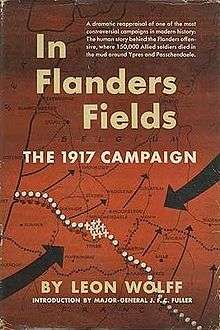In Flanders Fields: The 1917 Campaign

In Flanders Fields: The 1917 Campaign is a history of the 3rd Battle of Ypres by Leon Wolff published in 1958 with an introduction by Maj. Gen. J. F. C. Fuller, CB, CBE, DSO. A re-edition of the book was included in the Time-Life Reading Program in 1963, with an additional introduction by B. H. Liddell-Hart. A "Penguin Books" edition was published in 1979 "with minor emendations". Based on this a "Folio Society" edition was published in 2003 by "Cambridge University Press"
Synopsis
The first chapter "The Deadlock" is a brief description of the causes and events of World War I leading up to the year 1917. It details the military plans of the year by the French, British and German High Commands with considerable references to the diaries and official histories of the commanders and countries involved, the press, journalists, historians and political figures. There are maps and photographic plates of the battlefields in the book.
The Third Battle of Ypres is covered from the perspective of the high commands: the British Prime Minister of the day, Lloyd George, Sir Douglas Haig, Sir William Robertson, Robert Nivelle, Ferdinand Foch and others. There are short quotes from newspapers of the day and soldiers at the front, with sketches of the actual battlefield, compared with the views at Headquarters. Wolff gives official minutes of meetings with Lloyd George and the War Cabinet and diaries of high officers. If tacitly, Haig is implied as making large assumptions without intelligence about the German defences, enemy resources of men and guns, or the conditions of the battlefield.
The book also details the battles of 1917, from Nivelle's offensive and the French Army Mutinies (1917), Messines Ridge, Poelcapelle, Menin Road, the village of Passchendaele (fought by the Canadian Corps) and Ypres. It ends appropriately with a sequel of the end of the careers, and life after of Sir William Robertson, Sir Douglas Haig and David Lloyd George, quoting a line of Siegfried Sassoon's "On Passing the New Menin Gate" and ending finally with a satirical passage on war from Sartor Resartus by Thomas Carlyle[1]
Author's sources
A reference section follows for each chapter. Notable sources are Floyd Gibbons's The Red Knight of Germany, Sir Philip Gibbs's The Struggle in Flanders, Winston Churchill's The World Crisis, Liddell Hart (several books), Official Histories of the Great War of Great Britain, Australia, Canada and Germany, Sir Douglas Haig's published Private Papers, Hubert Gough's The Fifth Army, Erich Ludendorff's Ludendorff's Own Story, Sir Arthur Conan Doyle's The British Campaign in France and Flanders, volume iv, Robert Graves's Good-Bye to All That, David Lloyd George's War Memoirs, volume iv, Ernst Jünger's Storm of Steel, and John Monash's War Letters.
Notes
- ↑ "In Flanders Fields. The 1917 Campaign." Leon Wolff, 1958, pg. 233
References
- "In Flanders Fields: The 1917 Campaign", Leon Wolff, 1958.
- Readers Union Edition Longmans, Green & Co. London 1960, produced for sale to its members only by Readers Union Ltd. Book sourced at the University of the West Indies (St. Augustine Campus), Main Library.